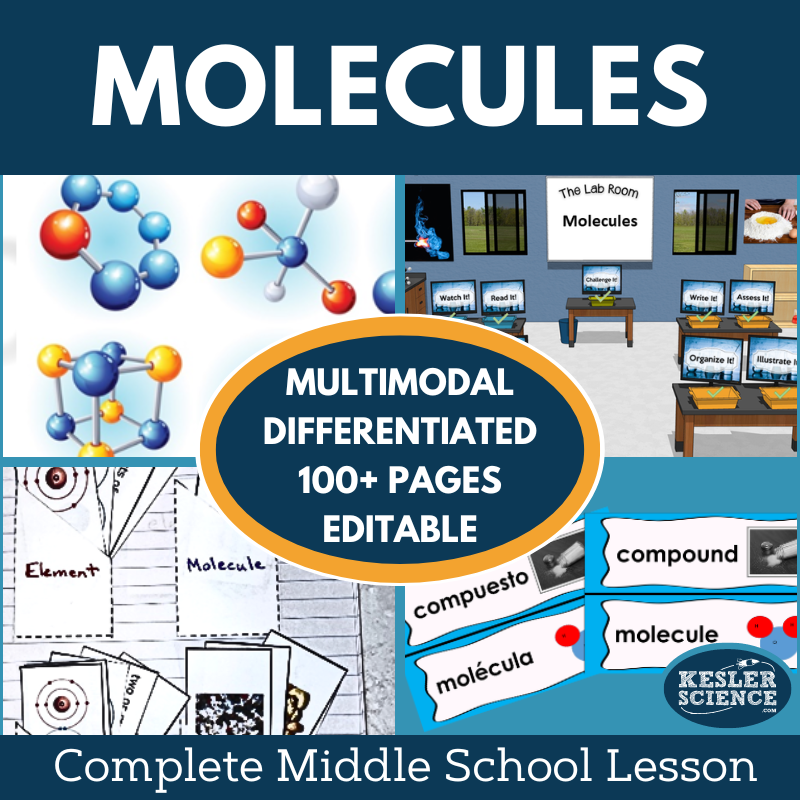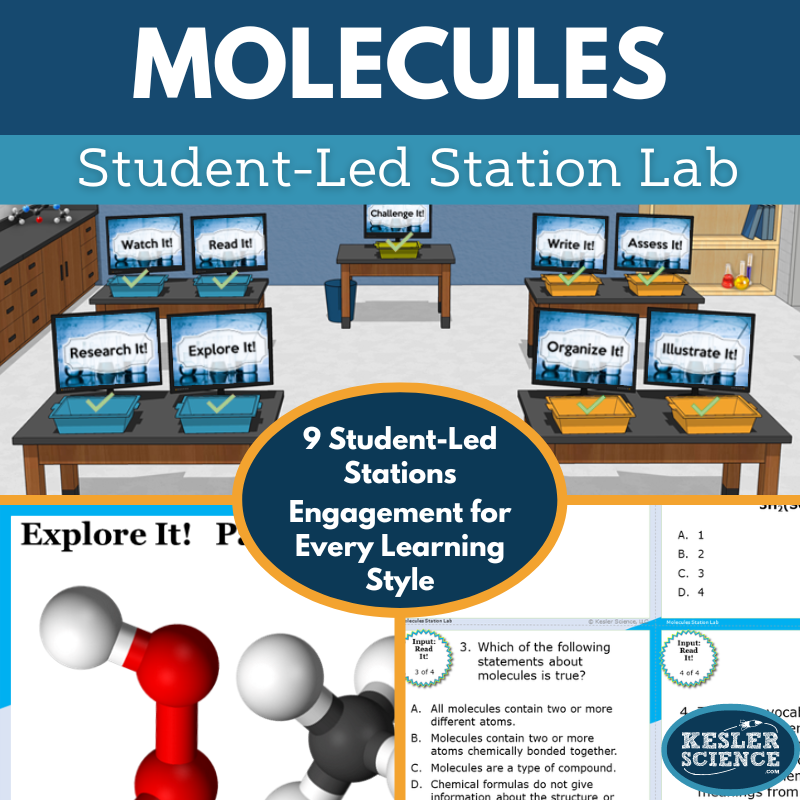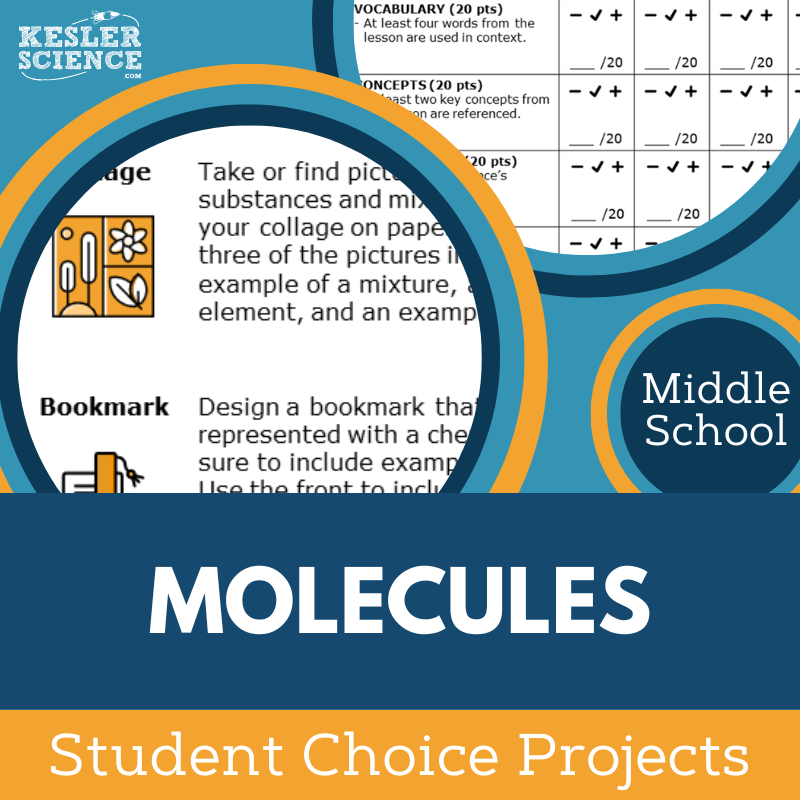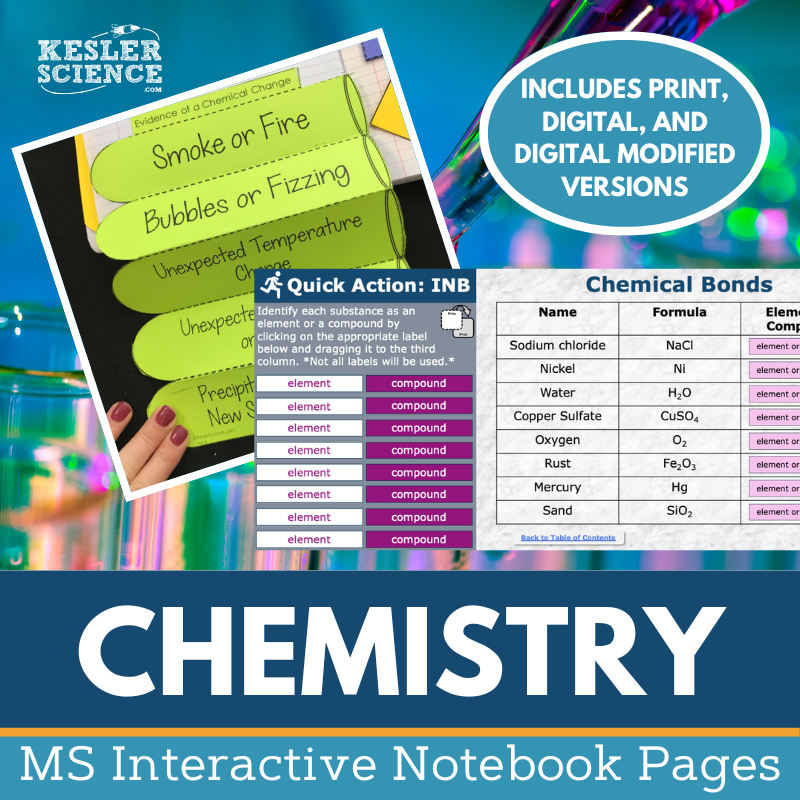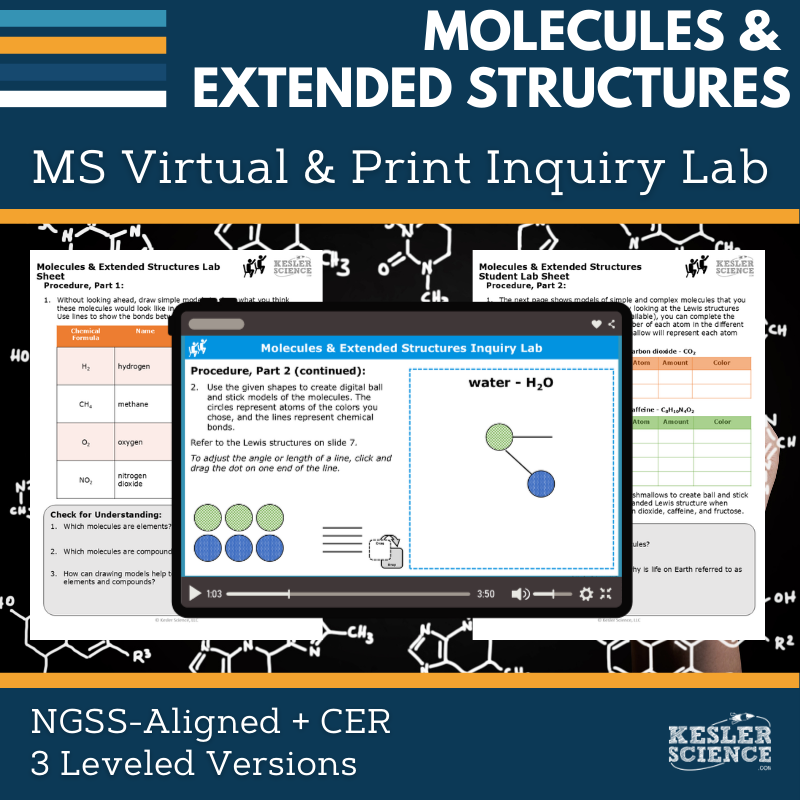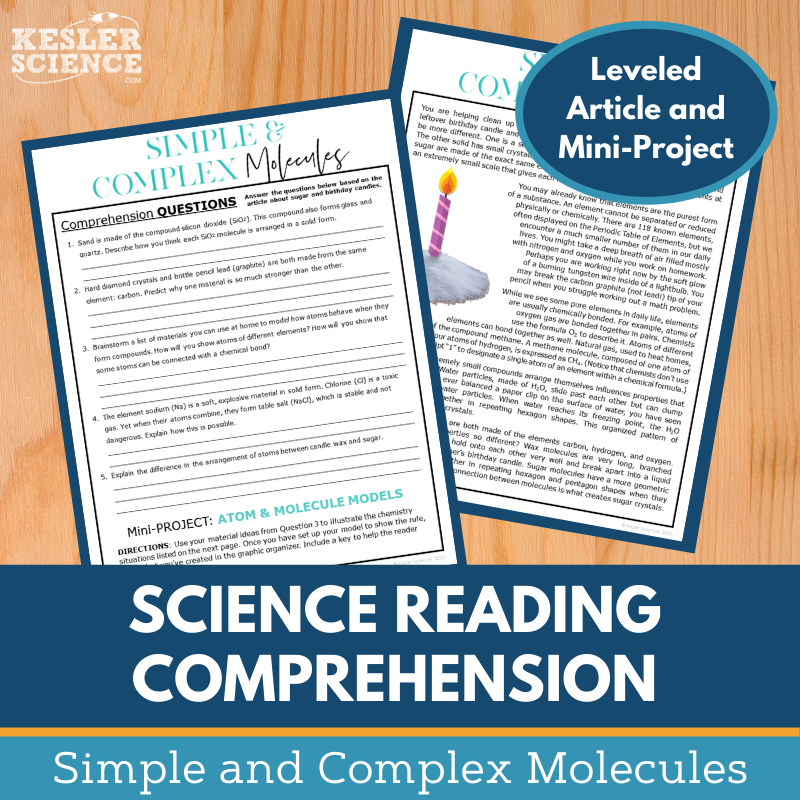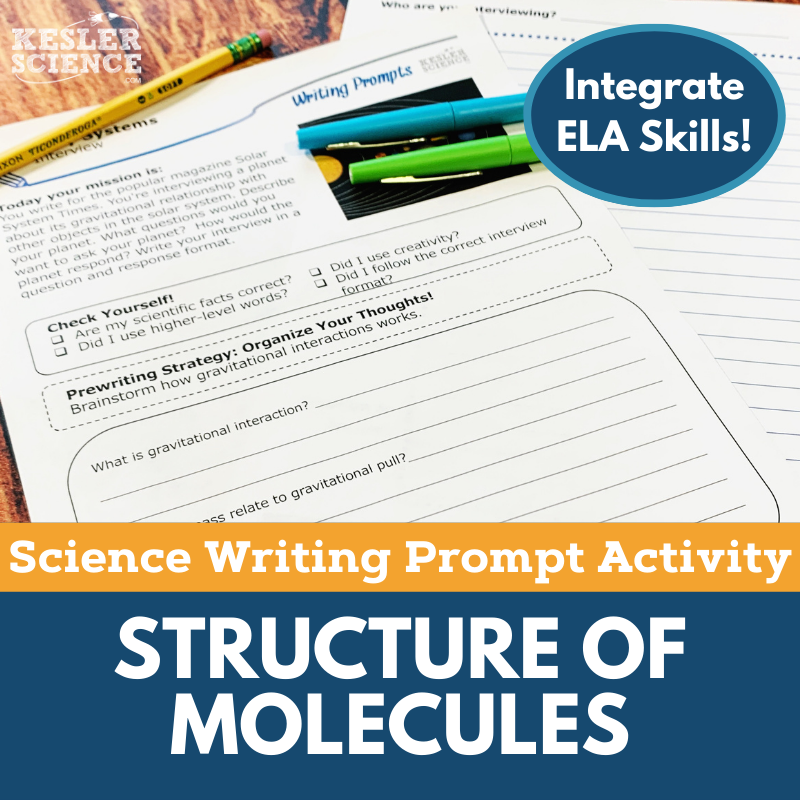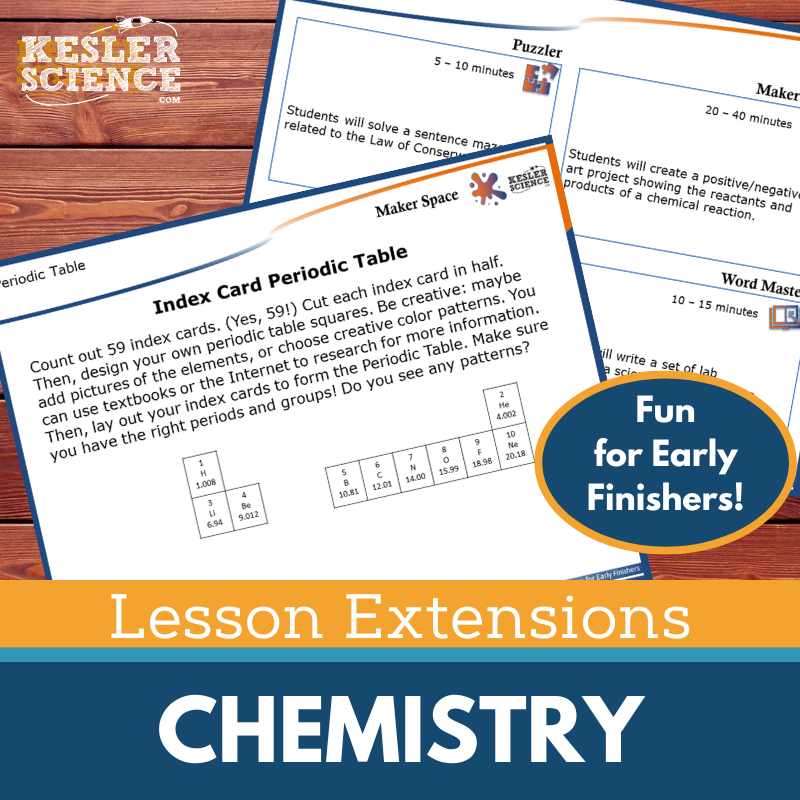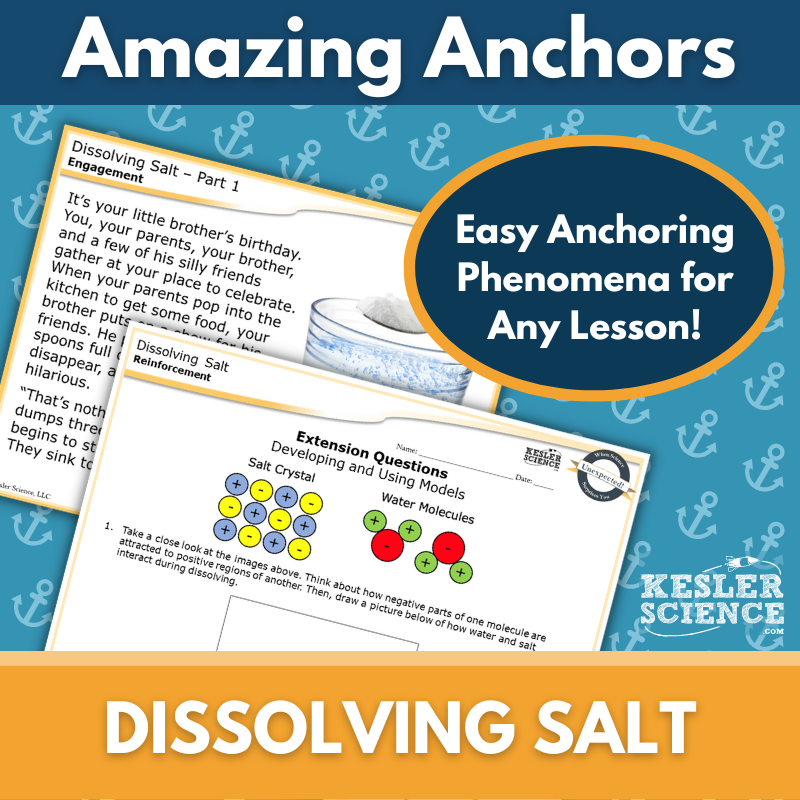Molecules Activities for Middle School Science
The Kesler Science Molecules resources offer a comprehensive, engaging, and differentiated approach to teaching middle school students about molecule models and pure substances, with materials for both in-person and virtual learning. The resources below will give students a comprehensive understanding of molecules. All of the following materials are also included in the Kesler Science Membership.
The Kesler Science Molecules Complete 5E Lesson offers a comprehensive, engaging unit on molecule models and pure substances for middle school students. Designed with differentiated, student-led learning in mind, this unit provides minimal prep time while maximizing flexibility with printable and digital formats. Students will explore key concepts through interactive activities, including station labs, presentations, and choice projects.
Based on the well-researched 5E Model, this unit includes five stages: Engagement, Exploration, Explanation, Elaboration, and Evaluation. Activities like hands-on demos, research tasks, and reading passages allow students to encounter molecular concepts in various ways, while output stations provide opportunities for them to showcase their learning through categorization, writing, and illustrating.
The lesson is designed for both in-person and virtual classrooms, offering editable PowerPoints, interactive notebooks, and Spanish translations for accessibility. Assessment materials are available in differentiated versions, ensuring all students have the support they need to succeed.
The Kesler Science Molecules Complete 5E Lesson offers a comprehensive, engaging unit on molecule models and pure substances for middle school students. Designed with differentiated, student-led learning in mind, this unit provides minimal prep time while maximizing flexibility with printable and digital formats. Students will explore key concepts through interactive activities, including station labs, presentations, and choice projects.
Based on the well-researched 5E Model, this unit includes five stages: Engagement, Exploration, Explanation, Elaboration, and Evaluation. Activities like hands-on demos, research tasks, and reading passages allow students to encounter molecular concepts in various ways, while output stations provide opportunities for them to showcase their learning through categorization, writing, and illustrating.
The lesson is designed for both in-person and virtual classrooms, offering editable PowerPoints, interactive notebooks, and Spanish translations for accessibility. Assessment materials are available in differentiated versions, ensuring all students have the support they need to succeed.
The Kesler Science modular, student-led Molecules Station Lab engages middle school students in learning about molecular structures while giving them the opportunity to direct their own learning. With eight differentiated stations and a bonus challenge station, this student-centered approach saves teachers time on preparation while encouraging independent exploration.
The stations include hands-on activities such as building models, reading, watching videos, and conducting research. Students will engage with multimodal tasks, like manipulating images in the digital version or answering questions from a short passage. The lab fosters creativity and critical thinking as students organize, illustrate, and assess their understanding of molecules.
Designed for both in-person and virtual learning environments, the station lab uses familiar classroom resources and offers digital alternatives for remote instruction. The flexible structure allows students to work independently or in groups while reinforcing key concepts about molecules.
The Kesler Science modular, student-led Molecules Station Lab engages middle school students in learning about molecular structures while giving them the opportunity to direct their own learning. With eight differentiated stations and a bonus challenge station, this student-centered approach saves teachers time on preparation while encouraging independent exploration.
The stations include hands-on activities such as building models, reading, watching videos, and conducting research. Students will engage with multimodal tasks, like manipulating images in the digital version or answering questions from a short passage. The lab fosters creativity and critical thinking as students organize, illustrate, and assess their understanding of molecules.
Designed for both in-person and virtual learning environments, the station lab uses familiar classroom resources and offers digital alternatives for remote instruction. The flexible structure allows students to work independently or in groups while reinforcing key concepts about molecules.
The Kesler Science Molecules Student Choice Projects allow middle school students to choose from six project options or create their own, providing a flexible way for them to demonstrate their understanding of molecules. With nine project choices and a customizable rubric, students can express their learning through various formats, including digital or hands-on creations.
The project includes teacher directions and editable rubric pages that assess vocabulary, concepts, presentation, clarity, and accuracy. Teachers can modify the rubric to meet their specific grading needs, while students can select from differentiated options based on their learning levels.
Designed to use everyday classroom supplies like paper, markers, and scissors, these projects encourage creativity and can be tailored to accommodate students requiring additional support or challenges.
The Kesler Science Molecules Student Choice Projects allow middle school students to choose from six project options or create their own, providing a flexible way for them to demonstrate their understanding of molecules. With nine project choices and a customizable rubric, students can express their learning through various formats, including digital or hands-on creations.
The project includes teacher directions and editable rubric pages that assess vocabulary, concepts, presentation, clarity, and accuracy. Teachers can modify the rubric to meet their specific grading needs, while students can select from differentiated options based on their learning levels.
Designed to use everyday classroom supplies like paper, markers, and scissors, these projects encourage creativity and can be tailored to accommodate students requiring additional support or challenges.
The Kesler Science Chemistry Interactive Notebook Bundle provides an engaging way for students to explore chemistry concepts through interactive activities. Designed for both traditional classrooms and digital learning environments, this bundle includes print and digital versions, making it versatile for in-person, 1:1, or distance learning settings.
Topics covered include acids and bases, atoms, balancing chemical equations, chemical bonds, physical and chemical changes, the periodic table, properties of water, and more. The digital version features a unique PowerPoint interactive notebook that can be uploaded to platforms like Google Slides, MS Teams, or Schoology. It includes reflection pages, note-taking space, a teacher answer key, and a modified version for students needing accommodations.
The paper version offers blank templates for student interaction, pre-filled options for modified learners or absentees, and visual examples for guidance. This resource is ideal for fostering hands-on and digital engagement in middle school chemistry.
The Kesler Science Chemistry Interactive Notebook Bundle provides an engaging way for students to explore chemistry concepts through interactive activities. Designed for both traditional classrooms and digital learning environments, this bundle includes print and digital versions, making it versatile for in-person, 1:1, or distance learning settings.
Topics covered include acids and bases, atoms, balancing chemical equations, chemical bonds, physical and chemical changes, the periodic table, properties of water, and more. The digital version features a unique PowerPoint interactive notebook that can be uploaded to platforms like Google Slides, MS Teams, or Schoology. It includes reflection pages, note-taking space, a teacher answer key, and a modified version for students needing accommodations.
The paper version offers blank templates for student interaction, pre-filled options for modified learners or absentees, and visual examples for guidance. This resource is ideal for fostering hands-on and digital engagement in middle school chemistry.
The Kesler Science Molecules and Extended Structures Inquiry Lab aligns with NGSS MS-PS1-1, guiding students to develop models that represent the atomic composition of simple and complex molecules. Students will build physical models of molecules commonly found in soda—such as water, carbon dioxide, fructose, and caffeine—using materials like marshmallows and toothpicks. Both print and digital versions of the lab include comprehension questions, C.E.R. writing prompts, and a reflection section to encourage deeper understanding.
This resource is fully differentiated with three versions at varying levels of support: dependent for on-level learners, modified for students requiring additional guidance, and independent for those ready for a more student-directed experience. The print lab offers a hands-on approach, while the digital format provides interactive activities that can be completed without physical materials—ideal for absent students or classrooms with limited supplies.
Designed for flexibility, the lab includes editable teacher pages, answer keys, and materials compatible with both PowerPoint and Google Slides. Whether students are building molecule models in person or virtually exploring structures, this lab supports diverse learning styles and classroom needs.
The Kesler Science Molecules and Extended Structures Inquiry Lab aligns with NGSS MS-PS1-1, guiding students to develop models that represent the atomic composition of simple and complex molecules. Students will build physical models of molecules commonly found in soda—such as water, carbon dioxide, fructose, and caffeine—using materials like marshmallows and toothpicks. Both print and digital versions of the lab include comprehension questions, C.E.R. writing prompts, and a reflection section to encourage deeper understanding.
This resource is fully differentiated with three versions at varying levels of support: dependent for on-level learners, modified for students requiring additional guidance, and independent for those ready for a more student-directed experience. The print lab offers a hands-on approach, while the digital format provides interactive activities that can be completed without physical materials—ideal for absent students or classrooms with limited supplies.
Designed for flexibility, the lab includes editable teacher pages, answer keys, and materials compatible with both PowerPoint and Google Slides. Whether students are building molecule models in person or virtually exploring structures, this lab supports diverse learning styles and classroom needs.
The Kesler Science Simple and Complex Molecules Reading Comprehension activity engages middle school students in learning about atomic composition through a nonfiction article on simple and complex molecules. After reading, students complete comprehension questions and create atom and molecule models as part of a hands-on mini-project.
This resource includes leveled science reading passages, suitable for grades 6-8 and higher-level 5th graders, with Lexile levels ranging from 1100-1300. Each passage is paired with comprehension questions and a mini-project to reinforce learning. The content is available in both English and Spanish and works well for both in-person and virtual learning environments.
Teachers can use this activity in various ways, such as for building science literacy, as extra credit, or in remote learning setups through platforms like Google Classroom. The included Cornell notes template and colorful graphics make it easier for students to engage and retain information while promoting critical thinking and classroom discussions.
The Kesler Science Simple and Complex Molecules Reading Comprehension activity engages middle school students in learning about atomic composition through a nonfiction article on simple and complex molecules. After reading, students complete comprehension questions and create atom and molecule models as part of a hands-on mini-project.
This resource includes leveled science reading passages, suitable for grades 6-8 and higher-level 5th graders, with Lexile levels ranging from 1100-1300. Each passage is paired with comprehension questions and a mini-project to reinforce learning. The content is available in both English and Spanish and works well for both in-person and virtual learning environments.
Teachers can use this activity in various ways, such as for building science literacy, as extra credit, or in remote learning setups through platforms like Google Classroom. The included Cornell notes template and colorful graphics make it easier for students to engage and retain information while promoting critical thinking and classroom discussions.
The Kesler Science Structure of Molecules Writing Prompt Activity helps middle school students explore the concept of molecular structure through an engaging song prompt. Students enhance their science reasoning and writing skills by responding creatively to the song. This activity is ideal for promoting student-led learning and can be used for both in-person and virtual classrooms.
This resource is fully aligned with TEKS and NGSS standards and provides multiple ways for students to demonstrate understanding. It includes differentiated materials such as full and half-sized handouts, pre-writing strategies, and rubrics for easy assessment. Teachers can project the prompt or use it digitally via Google Slides or PowerPoint.
The activity is flexible and low-prep, suitable for cross-curricular integration, formative assessments, and student choice projects. It also works as a creative extension for early finishers or as a tool for review, extra credit, or make-up work. With options for differentiation, this writing prompt can meet the diverse needs of all students.
The Kesler Science Structure of Molecules Writing Prompt Activity helps middle school students explore the concept of molecular structure through an engaging song prompt. Students enhance their science reasoning and writing skills by responding creatively to the song. This activity is ideal for promoting student-led learning and can be used for both in-person and virtual classrooms.
This resource is fully aligned with TEKS and NGSS standards and provides multiple ways for students to demonstrate understanding. It includes differentiated materials such as full and half-sized handouts, pre-writing strategies, and rubrics for easy assessment. Teachers can project the prompt or use it digitally via Google Slides or PowerPoint.
The activity is flexible and low-prep, suitable for cross-curricular integration, formative assessments, and student choice projects. It also works as a creative extension for early finishers or as a tool for review, extra credit, or make-up work. With options for differentiation, this writing prompt can meet the diverse needs of all students.
The Kesler Science Chemistry Lesson Extensions offer an engaging solution for keeping fast finishers motivated and learning. By incorporating activities that challenge critical thinking and creativity, these extensions are ideal for filling downtime during testing, curbing distractions, and wrapping up lessons. They provide rigorous yet enjoyable opportunities for students ready to delve deeper into NGSS and TEKS chemistry standards.
Each Lesson Extension includes four creative activities designed to enrich the learning experience. The Puzzler improves problem-solving skills through relevant puzzles, while the Maker Space integrates STEAM connections with hands-on projects. The Tech Connection allows students to demonstrate their learning through digital media, and the Word Master brings creative writing into the science classroom. Teachers are supported with clear directions, answer keys, and resources available in both projection and print-friendly formats.
This bundle covers essential topics such as the periodic table, chemical reactions, synthetic materials, and atomic structures. These versatile tools provide high-level supplementary materials to challenge independent learners and offer a meaningful way to conclude chemistry lessons with engagement and purpose.
The Kesler Science Chemistry Lesson Extensions offer an engaging solution for keeping fast finishers motivated and learning. By incorporating activities that challenge critical thinking and creativity, these extensions are ideal for filling downtime during testing, curbing distractions, and wrapping up lessons. They provide rigorous yet enjoyable opportunities for students ready to delve deeper into NGSS and TEKS chemistry standards.
Each Lesson Extension includes four creative activities designed to enrich the learning experience. The Puzzler improves problem-solving skills through relevant puzzles, while the Maker Space integrates STEAM connections with hands-on projects. The Tech Connection allows students to demonstrate their learning through digital media, and the Word Master brings creative writing into the science classroom. Teachers are supported with clear directions, answer keys, and resources available in both projection and print-friendly formats.
This bundle covers essential topics such as the periodic table, chemical reactions, synthetic materials, and atomic structures. These versatile tools provide high-level supplementary materials to challenge independent learners and offer a meaningful way to conclude chemistry lessons with engagement and purpose.
This Amazing Anchors Phenomenon Lesson introduces and reinforces the concept of atomic composition through a real-world scenario about disappearing salt. The two-part resource includes an introductory reading with comprehension and extension questions to spark curiosity, followed by an explanatory reading that clearly explains atomic composition and deepens student understanding with additional questions.
Designed to support NGSS standard MS PS1-1, this no-prep, teacher-friendly resource includes full-page projection slides, editable PowerPoints for digital learning, and printable handouts in both full- and half-sheet formats. Differentiated versions are included to support all learners, with modified language and sentence starters to guide student responses.
Ideal for the Engage and Elaborate phases of a 5E lesson, Amazing Anchors bookend your main instruction by building context and reinforcing key concepts. Whether used in person or virtually, this flexible resource helps students make meaningful connections through a phenomenon-based approach to science learning.
This Amazing Anchors Phenomenon Lesson introduces and reinforces the concept of atomic composition through a real-world scenario about disappearing salt. The two-part resource includes an introductory reading with comprehension and extension questions to spark curiosity, followed by an explanatory reading that clearly explains atomic composition and deepens student understanding with additional questions.
Designed to support NGSS standard MS PS1-1, this no-prep, teacher-friendly resource includes full-page projection slides, editable PowerPoints for digital learning, and printable handouts in both full- and half-sheet formats. Differentiated versions are included to support all learners, with modified language and sentence starters to guide student responses.
Ideal for the Engage and Elaborate phases of a 5E lesson, Amazing Anchors bookend your main instruction by building context and reinforcing key concepts. Whether used in person or virtually, this flexible resource helps students make meaningful connections through a phenomenon-based approach to science learning.
Year-Round Resources
These year-round activities will increase your students' understanding of many middle school science topics. All of these activities are also included in the Kesler Science Membership.
Visual Data & Graphing
You're not alone if your students struggle with understanding graphs, charts, and tables. It's a skill that takes an enormous amount of practice. This resource will help students build a strong foundation in analyzing data and creating their own data visualizations.
Bell Ringers and Warm-Ups
These middle school science bell ringers are an excellent way to engage your students as soon as they walk into your classroom. This comprehensive FULL YEAR resource includes everything you need to start off each science class with an interesting warm-up activity.
Review Board Games
Each game board has been carefully designed to keep students engaged. There are 10 different action spaces on each board and dozens of question cards. All of the actions are related to science concepts and keep the students motivated throughout the game.
Each game is ready to play. Simply print out the board and the cards and let the students enjoy reviewing nine different units.
Essential Questions
Below are the essential questions associated with the lessons and activities included in this unit. This topic is only one of more than 100 middle school science topics included in the Kesler Science Membership.
-
What is a pure substance?
-
What can be represented with chemical symbols?
Kesler Science Membership
Imagine never having to search for another middle school science lesson again. The membership gives you access to ALL of the Kesler Science products in one place (Yes, including everything above).
Say goodbye to long hours of lesson prep.

